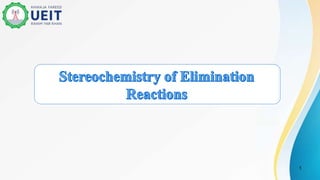
Stereochemistry of elimination reactions
- 1. 1
- 2. E1 reactions can be stereoselective For some eliminations only one product is possible For others may be a choice of two (or more) alkene products Differ either in the location or stereochemistry of the double bond Factors that control the stereochemistry and regiochemistry of the alkenes Starting with E1 reactions 2
- 3. 3
- 4. For steric reasons E-alkenes are lower in energy than Z-alkenes Substituents can get farther apart from one another Reaction that can choose which it forms is likely to favour the formation of E-alkenes For alkenes formed by E1 elimination, less hindered E-alkene is favoured 4
- 5. Geometry of the product is determined when the proton is lost from intermediate carbocation New pi bond only form if vacant p orbital of carbocation and breaking C–H bond are aligned parallel Two possible conformations of the carbocation with parallel orientations, one is more stable than the other Suffers less steric hindrance Transition states on the route to the alkenes E-alkene is lower in energy and more E-alkene than Z-alkene is formed Stereoselective, reaction chooses to form predominantly one of two possible stereoisomeric products 5
- 6. 6
- 7. Tamoxifen, important drug in the fight against breast cancer, one of the most common forms of cancer Works by blocking the action of the female sex hormone estrogen Tetrasubstituted double bond can be introduced by an E1 elimination 7
- 8. E1 reactions can be regioselective E1 eliminations that can give more than one regio isomeric alkene Major product is the alkene that has the more substituents, more stable of two possible products More substituted alkenes are more stable Stabilized when empty p* antibonding orbital can interact with filled orbitals of parallel C–H and C–C bonds More C–C or C–H bonds there are, more stable the alkene 8
- 9. 9
- 10. More substituted alkene is more stable, does not explain why it one forms faster Transition states leading to the two alkenes Both form from the same carbocation, which one depends on which proton is lost Removal of the proton on the right leads to a transition state in which there is a monosubstituted double bond partly formed Removal of the proton on the left leads to a partial double bond that is trisubstituted More stable—the transition state is lower in energy, more substituted alkene forms faster 10
- 11. 11
- 12. E2 eliminations have anti-periplanar transition states New pi bond is formed by the overlap of C–H s bond with C–X s* antibonding orbital Two orbitals have to lie in same plane for best overlap Two conformations that allow this One has H and X syn-periplanar Other anti-periplanar Anti-periplanar conformation more stable, staggered Syn-periplanar conformation is eclipsed but, Only in the anti-periplanar conformation are the bonds (and therefore the orbitals) truly parallel 12
- 13. E2 eliminations take place from the anti-periplanar conformation E2 elimination gives mainly one of two possible stereoisomers 2-Bromobutane has two conformations with H and Br anti-periplanar One that is less hindered leads to more of the product, and the E-alkene predominates 13
- 14. There is a choice of protons to be eliminated • Stereochemistry of the product results from which proton is anti-periplanar to the leaving group • when the reaction takes place, and the reaction is stereoselective as a result 14
- 15. E2 eliminations can be stereospecific Next example, one proton take part in the elimination No choice of anti-periplanar transition states Whether the product is E or Z, E2 reaction has only one course to follow Outcome depends on which diastereoisomer of starting material is used When first diastereoisomer is drawn with the proton • Bromine anti-periplanar, as required, in the plane of the page, • Two phenyl groups have to lie one in front and one behind the plane of the paper As hydroxide attacks the C–H bond and eliminates Br • This arrangement is preserved and the two phenyl groups end up trans (the alkene is E) 15
- 16. 16
- 17. Second dia-stereoisomer forms Z-alkene for the same reasons: • Two phenyl groups are on the same side of H–C–C–Br plane in reactive anti- periplanar conformation, end up cis in the product • Each diastereoisomer gives a different alkene geometry at different rates First reaction is about ten times as fast as the second • Anti-periplanar conformation only reactive one, not necessarily the most stable Newman projection for second reaction shows that two phenyl groups have to lie synclinal (gauche) to one another: • Steric interaction between these large groups at any time • Relatively small proportion of molecules adopt the right conformation for elimination, slowing the process down 17
- 18. Reactions in which the stereochemistry of the product is determined by the stereochemistry of the starting material are called stereospecific Stereoselective reactions give one predominant product because the reaction pathway has a choice. Either pathway of lower activation energy is preferred (kinetic control) or more stable product (thermodynamic control) Stereospecific reactions lead to the production of a single isomer as a direct result of mechanism of reaction and the stereochemistry of the starting material There is no choice Reaction gives a different dia-stereoisomer of the product from each stereoisomer of the starting material 18